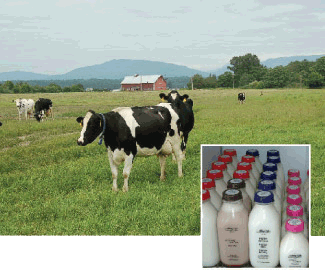New all-natural, local milk: Golden Glen Creamery
This article was originally published in August 2007

(August 2007) — You may already be a fan of the Golden Glen cheeses sold in PCC’s delis — a variety of herbed cheddars and feta. But now you’ll be seeing Golden Glen milk in the dairy case as well.
What makes it special? To start with, this milk comes from a local herd of cows just a moo away, in the picturesque Skagit Valley.
Golden Glen Creamery is a family-owned operation on the Vic Jensen & Sons farmstead — 145 owned acres and 60 leased acres, all farmed sustainably using many organic principles. The farm has been in operation for well over 40 years and has survived low milk prices, high feed and fuel prices, devastating snowstorms, and floods — held together by the family’s will and passion for farming.
Vic and Judy Jensen come from a long line of dairy farmers and now are sharing the legacy with their children and grandchildren. Today, there are three generations of Jensen family members living on the farm.
The Jensens’ 63 milk cows are mostly Holstein, but include Guernsey, too. Vic and Judy Jensen originally started the dairy with Guernseys only but, by the 1980s, banks typically wouldn’t loan to a dairy farmer that didn’t keep Holsteins (known for their productivity). The Jensens, however, have kept Guernseys in the mix because of the additional cream they give and also for their more docile, friendlier nature.
The herd is a closed-herd, meaning all the milk cows are born and raised on the farm with none brought in from the outside — a good safeguard against disease. The cows are pastured during the spring, summer and early fall, then during the winter they’re housed in an open-air barn to help reduce the number of foot problems that occur with saturated ground.
Along with pasturing, Doug Jensen supplements the herd’s diet with homegrown hay, corn and grass silage, as well as grain and alfalfa from eastern Washington.
The farm does not use rBST (genetically engineered growth hormones) to produce its milk and selectively and carefully administers antibiotics only to those cows that otherwise would die from an easily treated infection or illness; Brandy Jensen believes it’s the humane thing to do.
If long life is an indicator of health, the Jensen cows have a story to tell; the average American cow may live to be about 6 years old while some of the Jensen’s cows have lived to 16! Brandy credits the way they treat their cows and the wholesome environment for their long lives.
Last October, the Creamery started bottling its own milk in old-fashioned, glass bottles, continuing its all-natural approach. The glass can be reused up to 40 times, reducing toxic emissions from manufacturing plastic jugs, and then can be recycled — the “3R” concept in action. The Jensens feel the glass also gives the milk a more natural, nostalgic, appealing look and keeps its original flavor alive without any leaching from plastic jugs.
Golden Glen also uses an older, gentler method of pasteurizing called slow batch pasteurizing. This creamery understands that milk “bruises” just like fruit the more it’s handled, so they handle it as little as possible to keep its fresh flavor. (It’s the closest thing to raw!) This type of pasteurizing produces a shorter shelf-life for the milk, about 20 days instead of six to 12 weeks,1 which isn’t fresh enough for the Jensen family standard.
In keeping with the all-natural, less-handled approach, the Jensen family does not homogenize its milk, which is why it is called “cream top.” This means the cream is not artificially burst into unnaturally small particles to suspend it evenly throughout the fluid2; it naturally floats to the surface.
Golden Glen also does not fortify its milk, and even the chocolate milk and seasonal egg nog are made from traditional, home recipes — no artificial flavors, coloring, preservatives, stabilizers or emulsifiers.
Golden Glen Creamery and the Jensen family provide to the public only what they’d put on the table for their own families: healthy, all-natural dairy products that taste and look the way they should, from their family to yours. Naturally!
- The standard industry techniques are high temperature sterilization (HTST) or ultra-high temperature (UHT) pasteurization.
- Fat globules in homogenized milk may be small enough to be absorbed whole into the bloodstream. The globules encapsulate an enzyme xanthine oxidase and allow it to be free in the blood after the fat is dispersed. Some researchers have tagged bovine XO with a radio-isotope and detected it in the plaques on artery walls. In other words, there’s some evidence suggesting that homogenized milk is associated with arterial plaque.
